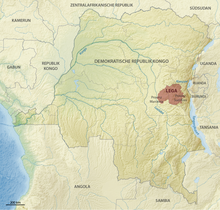Lega (ethnicity)
The Lega (also Mulega or Balega , formerly Warega ) are an ethnic group from the east of the Democratic Republic of the Congo . Today they live in an area east of the Lualaba , around its tributaries Elila and Ulindi . Administratively, the main settlement area comprises the Pangi district in the Maniema province and the Mwenga and Shabunda districts in the Sud-Kivu province . They speak the Bantu language Kilega in different dialects. In 1973 their number was estimated at around 225,000.
Culture
The Lega live traditionally from agriculture , hunting and fishing . They are known for carved objects made of wood and ivory .
The Lega have no centralized political power or a king; the individual villages and clans are led by chiefs whose status cannot be inherited. In contrast, there is a hierarchical Bwami society with a supraregional reach; this can exercise indirect influence on the chiefs. The Bwami society strives for a humanistic morality, the beautiful and the good, comparable to the Greek Kalokagathia . Each stage within society has specific initiation rites and is entered voluntarily by the applicant. The level reached is indicated by the type of mask and other carved objects.
history
It is believed that the Lega's ancestors came from the territory of what is now Uganda . They later inhabited the area around Ubundu (Ponthierville) on Lualaba , but had to move south because they were harassed by other ethnic groups. First they reached the area between the Lowa and Ulindi rivers and later their current settlement area, the Legaland , further south. In the 19th century the Arab influence from East Africa grew and the settlement area of the Lega was encircled by Arab trading centers, whose main goods were ivory and slaves. Although the Lega withdrew to more inaccessible areas in the middle of the rainforest, they were still attacked by slave catchers . During the time of the Congo Free State , the Lega area remained under Arab control. B. by Tippu-Tip . The later war of the Belgian Congo against the Arabs (1892–1895) was mainly waged outside the Lega territory and ended in a defeat for the Arabs. From 1902 the Belgians gradually occupied the Lega territory. However, because of the decentralized power structure, the earlier agreements between Arabs and the local chiefs and the diffuse Bwami society, they had problems really controlling the area. The first Christian mission was opened in 1908, and others followed. From 1923 mining developed into an important economic factor, which led to a reorganization of the traditional Lega culture. In some areas up to half of the Lega worked in mining; the Belgian administration forced a change in agriculture to ensure the food supply. A small part of the Lega lived in Rwanda until 1994; the civil war that broke out in 1994 forced them to flee.
literature
- Daniel P. Biebuyck: Lega Culture; Art, Initiation, and Moral Philosophy Among a Central African People , University of California Press, 1973, ISBN 0520020855 , Google Books.
Web links
Individual evidence
- ↑ Biebuyck: Lega Culture , 1973, p. 1
- ↑ Biebuyck: Lega Culture , 1973, pp. 11-12
- ↑ Biebuyck: Lega Culture , 1973, p. 3
- ↑ Biebuyck: Lega Culture , 1973, p. 16
- ↑ Carol Finley: The Art of African Masks: Exploring Cultural Traditions , Lerner Publications, 1998, ISBN 9780822520788 , p. 52 [1]
- ↑ Heinrich Balz: Ngoe - Osiris - Aeneas, Three Studies on Founders and Ancestors , LIT Verlag Münster, 2014, ISBN 9783643124715 , pp. 66–67 [2]
- ↑ Carol Finley: The Art of African Masks: Exploring Cultural Traditions , Lerner Publications, 1998, ISBN 9780822520788 , p. 52 [3]
- ↑ Biebuyck: Lega Culture , 1973, pp. 11-14
- ↑ James Stuart Olson : The Peoples of Africa: An Ethnohistorical Dictionary , Greenwood Publishing Group, 1996, ISBN 9780313279188 , p. 331 Google Books.

